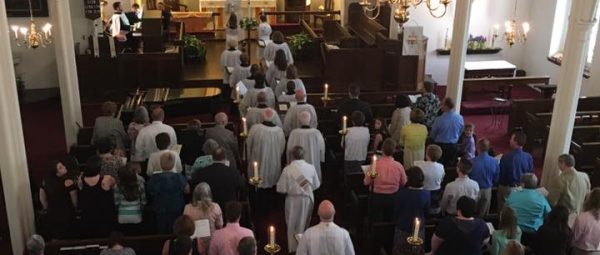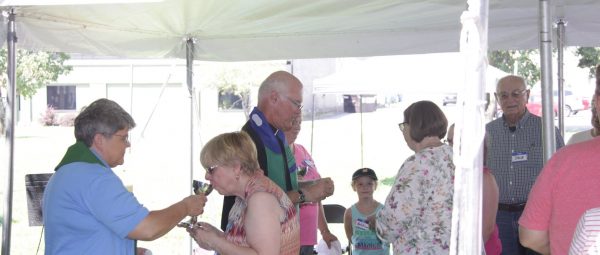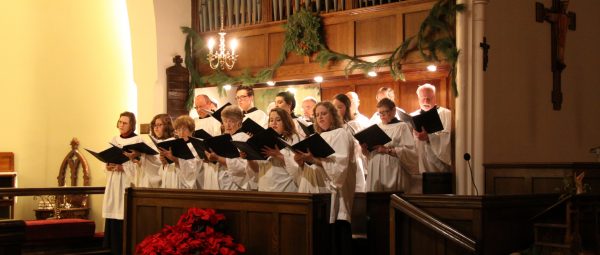Sunday Worship
11:15 a.m., Holy Eucharist, Rite I (in Lent)
Traditional worship style, traditional language, with music
Following the 11:15 a.m. service, please join us for Coffee Hour, a time for refreshments and Christian fellowship. We’d love to get to know you better.
We’re glad you are reading more about worship at All Saints’!
What should I expect on a usual Sunday morning at All Saints’?
When you visit us for worship, you will receive a bulletin from an usher or greeter. The bulletin is a quick start guide, outlining the service, and listing page numbers for service music, unison responses, and prayers. The bulletin also indicates when it is customary to sit, stand, or kneel, as you are able; however, none of these postures are required and you may do as little or as much as you are comfortable.
May I receive Holy Communion at All Saints’?
Baptized Christians, regardless of denominational affiliation or current congregational membership status, are invited to receive Holy Communion at All Saints’. If you’d rather, you may come forward to receive a blessing by silently signifying your desire by crossing your arms across your chest, with your hands on each shoulder.
If you are interested in the sacrament of Baptism or in having your membership transferred to All Saints’, please speak to a member of the clergy during your visit or contact the church office to begin the process.
What is this business about Rite I and Rite II?
The rites use different styles of language. The Rite I service uses traditional language (i.e. “thee,” “thine,” “we acknowledge and bewail our manifold sins and wickedness,” etc.), and the Rite II service uses contemporary language (i.e. “you,” “yours,” “we confess that we have sinned” etc.). The primary liturgical components and worship style of each of the rites are similar, but the use of the English language is the primary difference.
We use the Rite II option most frequently; however, we occasionally use Rite I during the penitential seasons of Advent and Lent (if you aren’t quite sure what these seasons are all about, click here to read more about these seasons and the role of the calendar of the church year).
Holy Eucharist, Rite I
- This service reflects the language and piety of the Elizabethan era, although the structure of this service reflects the influence of modern liturgical scholarship.
- Features: Three lessons from scripture and a Psalm, a sermon, and Holy Communion, with hymns and other service music led by a choir, accompanied by pipe organ or piano.
- This service is less than one hour long.
- Preview the format of the Rite I service in the Book of Common Prayer.
- For those with children, The Sunday Paper and The Sunday Paper, Jr. are available and contain age-appropriate reflections and activities to enliven each week’s scripture lessons.
Holy Eucharist, Rite II
- This service reflects more fully the influence of the Liturgical Movement and contemporary theology, using contemporary, more inclusive language.
- Features: Three lessons from scripture and a Psalm, a sermon, and Holy Communion, with hymns and other service music led by a choir, accompanied by a pipe organ or piano.
- This service is slightly longer than one hour.
- Preview the format of the Rite II service in the Book of Common Prayer.
- For those with children, The Sunday Paper and The Sunday Paper, Jr. are available and contain age-appropriate reflections and activities to enliven each week’s scripture lessons.
- In addition, there is a multi-age Christian education class during the first half of the 11 a.m. service in the education wing. Children join their families at the Peace, immediately before Holy Communion.
I’ve read about the differences between Rite I and Rite II services, but I’m not sure I understand all of the parts of the service or why they happen.
You’re in luck! The Rev. Greg Goebel has anticipated some of the questions one might have about worship in our tradition and he has encouraged us to share the following information from his blog.
Word and Sacrament
Our worship services consist of two parts: the Service of the Word and the Service of the Sacrament (Holy Communion). These two elements are equally important as the Word of God reveals Jesus and prepares us to receive Him in the Sacrament. This pattern follows the early Church in the Book of Acts, who “devoted themselves to the apostles’ teaching and the fellowship, to the breaking of bread and the prayers” (Acts 2:42).
The Service of the Word
Hearing God’s Word read and proclaimed, praying together, and preparing for Holy Communion.
The Procession and Acclamation
We prepare our hearts for worship in quiet prayer and song. The ministers and choir process behind the cross, reverencing the cross because everything we do is under the Cross of Christ. The People may also bow their heads as the cross passes. We name and bless the object of our worship, the God of the Christian Faith, revealed in Scripture as Father, Son, and Holy Spirit.
The Collect of the Day and the Collect for Purity
A ‘Collect’ is a prayer that “collects” the intentions of all the people and sums them up by acknowledging God’s work, asking of him, and ending with a doxology of praise. This collect sets a theme for the day and week.
The Scripture Lessons
Holy Scripture is at the heart of our worship and faith. We read from a lectionary, a common pattern of Scripture texts. This helps us to worship together with other Christians, even though we are in different places. St. Paul wrote that we should continue in the public reading the Scriptures. (I Timothy 4:13).
The Holy Gospel
The gospel is read “among the people” because Christ came into he world to live among us, and so the Gospel is the center of our parish life (See John 1:1-14, and 1 Corinthians 3:11). The “little” sign of the cross may be used with the thumbnail over the forehead, the lips, and the heart, signifying our prayer that the Gospel would fill our minds, be upon our lips, and in our heart.
The Sermon
Everything we learn about our Faith in Christ is embodied. It is sacramental, in that there is a means through which every aspect of the cure of our souls is effected. We need to hear a human voice speaking. We need that human voice to speak through personal experience and personality. We need to hear the Gospel, explained and illustrated, out loud. (Romans 10:14).
The Creed
The Apostle Jude taught us that we should “contend for the faith that was once for all delivered to the saints.” The Nicene Creed was produced by Christians from East and West at a time when the Church was undivided and is an expansion of the earlier Apostles’ Creed. By “catholic and apostolic” we mean the faith and order of the early Church and the Faithful throughout history and around the world today.
The Prayers of the People
Paul wrote to Timothy that, “supplications, prayers, intercessions, and thanksgivings be made for all people…” (1 Timothy 2:1).
We pray for those who have departed this life in faith because together with them we await the final Resurrection of our bodies (I Thessalonians 4:17 and 5:10). They rest in him now in peace, and yet cry out “how long, O Lord?” (Revelation 6:10). As One Body of Christ, we share communion with the faithful on earth and in heaven (I Corinthians 12:12) . Our prayers remind us of their example of faith and call us to follow it.
The Confession of Sin and the Absolution
We are forgiven in Christ at our baptism, but not yet perfected. As St John wrote, “If we confess our sins, he is faithful and just to forgive us our sins and to cleanse us from all unrighteousness” (1 John 1:9).
The absolution, or pronouncement of forgiveness, makes present to us the truth that “there is therefore now no condemnation for those who are in Christ Jesus” (Romans 8:1).
The Passing of the Peace
The passing of the peace is a renewal of our obedience to the command of our Lord in Matthew 5:24, “First be reconciled to your brother, and then come and offer your gift” and the admonition of St Paul to the Corinthians, “Aim for restoration, comfort one another, agree with one another, live in peace; and the God of love and peace will be with you” (2 Corinthians 13:11).
Holy Communion
Baptism is the initiation into the Christian life, a one-time moment of promise in which the people of God stand on his new covenant of grace to freely welcome a new member into the Body of Christ. Holy Communion is the on-going sacrament, the continually sustaining provision of God to nourish our faith and to regularly and constantly remind us of his mercy and to provide us his grace.
The Offering
The offering of our resources to God by giving to our local parish is a tangible expression of God’s ownership of all things, including our whole selves. Visitors are never required to give money during the offering.
The Great Thanksgiving
The prayers of the Eucharist service, which acknowledge that our Lord instituted this table for his people to commune with him together as his people. The Great Thanksgiving is the name for the cluster of prayers that surround the Lord’s Supper or Communion. These prayers are based on ancient Christian prayers and the pattern of prayer from the earliest days of the Church, which are derived from Holy Scripture.
The prayers are not identical, but they follow a pattern that includes a recitation of salvation history, an ‘oblation’ or declaration of the continuing power of Christ’s one time sacrifice on the cross for the forgiveness of sins. They include ancient hymns and songs such as the Sanctus or “Holy, Holy, Holy”. They always include the words of institution, that is, the words Jesus said when he instituted the Lord’s Supper.
The Celebrant (a priest who leads these prayers) takes bread by placing it on the table. He gives thanks along with the people. He breaks it, signifying both Christ’s body broken and the shared nature of communion. And then he gives it, administering the body and blood of Christ to the people of God.
The Words of Institution
St Paul wrote to the Corinthians in his first epistle, chapter 11:23-26, “For I received from the Lord what I also delivered to you, that the Lord Jesus on the night when he was betrayed took bread, and when he had given thanks, he broke it, and said, ‘This is my body which is for you. Do this in remembrance of me.’ In the same way, also he took the cup after supper, saying, ‘This cup is the new covenant in my blood. Do this, as often as you drink it, in remembrance of me.’ For as often as you eat this bread and drink the cup, you proclaim the Lord’s death until he comes.” He then adds an exhortation, “Let a person examine himself, then, and so eat of the bread and drink of the cup.” We re-present this every week.
The Lord’s Prayer
The Lord himself gave it to us, and it is the outline and basis of all Christian prayer (Matthew 6:9-13).
Receiving Communion
All baptized believers are welcome to receive at the Lord’s table. Fold hands flat together to receive the bread. Guide the chalice to your lips. Many will make the sign of the cross before receiving each kind, and after receiving say, “amen.” You may also choose to receive by intinction (dipping) the bread into the wine and consume both together.
Those who are not baptized, or are not receiving communion for other reasons, but would like to receive a blessing by a priest, may indicate so by crossing their arms on their chest, with hands at each shoulder. Unbaptized children are welcome to receive a blessing as well.
Post-Communion
Having received from our Lord Jesus Christ in Word and Sacrament, we are sent forth into the world as ministers of reconciliation in his name (2 Corinthians 5:18).
The Blessing
The blessing is rooted in Aaron’s blessing (Numbers 6:22-26). It also reflects Paul’s doxologies in his Epistles, most notably Romans 15:13,33 and Philippians 4:7.



